by Steve Paulus, DO
 When I was an Osteopathic medical student in the early 1980’s we had very little exposure to the direct writings of A. T. Still. There was no portion of our curriculum devoted to studying the four books written by Still. Research and Practice had been out of print since 1910 and our library carried only one tattered copy that was almost always checked out. As a student, I longed for a teacher who would help me to appreciate, understand, and interpret what the founder of Osteopathy recorded. Over the years, I purchased reprinted copies of the Autobiography of A. T. Still, Philosophy of Osteopathy, Philosophy and Mechanical Principles of Osteopathy, and ultimately the newly republished Research and Practice. I read them cover-to-cover. The joy of reading Still’s authentic written works was exciting and stimulated my growth as an Osteopath. While reading certain passages, I became inspired knowing that William Sutherland, DO and J. Martin Littlejohn, DO, MD had read the same words and expanded the teachings of Still beyond the confines of time, proving that Osteopathy is a living science and art.
When I was an Osteopathic medical student in the early 1980’s we had very little exposure to the direct writings of A. T. Still. There was no portion of our curriculum devoted to studying the four books written by Still. Research and Practice had been out of print since 1910 and our library carried only one tattered copy that was almost always checked out. As a student, I longed for a teacher who would help me to appreciate, understand, and interpret what the founder of Osteopathy recorded. Over the years, I purchased reprinted copies of the Autobiography of A. T. Still, Philosophy of Osteopathy, Philosophy and Mechanical Principles of Osteopathy, and ultimately the newly republished Research and Practice. I read them cover-to-cover. The joy of reading Still’s authentic written works was exciting and stimulated my growth as an Osteopath. While reading certain passages, I became inspired knowing that William Sutherland, DO and J. Martin Littlejohn, DO, MD had read the same words and expanded the teachings of Still beyond the confines of time, proving that Osteopathy is a living science and art.
My copies of Still’s publications are dog eared, underlined, and highlighted with notes in the margins demonstrating their workbook like function. Recently while reading George Webster’s Sage Sayings of Still, a thought struck me that a new version of “sage sayings” was needed. Yet, I questioned the proper name to call a collection of Still’s thoughts, ideas, and inspirations.
While studying Hippocrates, I was impressed by the title and organization of the Aphorisms of Hippocrates—the first known “medical textbook” in the western world. The writings which now go by the name of the “Hippocrates Collection” were not written by Hippocrates, but were brought together by different generations of his students. Hippocrates himself was not known to have left any direct written teachings. In fact, much of what we know of the historical Hippocrates is completely dependent upon Plato.
However, after exploring the meaning of aphorism, I was not satisfied this word would fit as a title leading a collection of A. T. Still’s condensed yet undiluted teachings. Aphorism is defined as a succinct saying expressing a general truth or opinion. It can be taken as a maxim, proverb or cliché.
It was the work of Confucius that gave me the idea for the title of a “new” excerpted version of Still’s work. The Analects of Confucius is a classic Chinese text containing a patchwork of concise statements and stories compiled by successive generations of disciples over 75 years after the death of the master teacher, philosopher, statesman, and scholar.
Analects, as a word, fit perfectly as the heading for a concise expression of Still’s work. Analects are defined as brief selected passages or quotations, published as a collection, from the writings of one or more authors.
It is certainly true that Still expressed generalized truths or opinions consistent with aphorisms. But he was much more directed and less casual in his writing style. Still was a unique physician. He combined the qualities of a philosopher and reformer with that of a clinician devoted to helping his fellow human being. Like Confucius and Hippocrates, A. T. Still was a dedicated and fervent teacher passing on his wisdom to students through the oral tradition and by giving opportunities for individual direct perceptual experiences.
Unlike the followers of Confucius or Hippocrates, we are left with a small selection of Still’s immediate and unbroken teachings recorded in his four books and in dozens of journal articles. Thus, as students of Osteopathy, we are blessed with having unadulterated words from our founder.
Presented to every student of Andrew Taylor Still’s are these selected passages organized in categories to offer greater accessibility. Use these direct, unchanged teachings as a stepping stone for appreciating the timeless instructions of a modern day master.
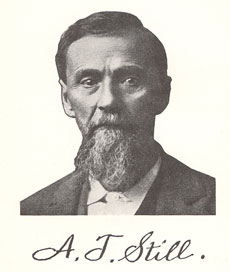
1. The Foundation Stone
Is God an Architect? If so why not be governed by the plan, specification, building and engineering of that Architect in our work as healers? When we conform to and work by the laws and specifications of this Architect, we get the results required. This is the foundation stone on which Osteopathy stands.
—Osteopathy Research and Practice
God is the Father of Osteopathy, and I am not ashamed of the child of His mind.
—Autobiography of A. T. Still
In this work we must depend upon the absolute law of Deity for results. If you object to that, all right; you may take guesswork, if you choose, I will not lose my hold on Deity.
—Autobiography of A. T. Still
I quote no authors but God and experience.
—Philosophy and Mechanical Principles of Osteopathy
I find in man a miniature universe.
—Autobiography of A. T. Still
2. Nature: The Laws of Life
We can do no more than to deed and trust the laws of life as Nature gives them to man.
—Philosophy and Mechanical Principles of Osteopathy
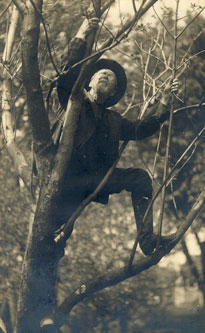 I am simply trying to teach you what you are; to get you to realize your right to health, and when you see the cures wrought here, after all other means have failed, you can but know that the foundation of my work is laid on nature’s rock.
I am simply trying to teach you what you are; to get you to realize your right to health, and when you see the cures wrought here, after all other means have failed, you can but know that the foundation of my work is laid on nature’s rock.
—Autobiography of A. T. Still
Osteopathy is to me a very sacred science. It is sacred because it is a healing power through all nature.
—Osteopathy Research and Practice
The Osteopath who succeeds best does so because he looks to Nature for knowledge and obeys her teachings . . .
—Osteopathy Research and Practice
Nature has no apology to offer. It does the work if you know how to line up the parts; then food and rest that is required.
—Osteopathy Research and Practice
Health is Nature.
—Philosophy and Mechanical Principles of Osteopathy
When we take up the principles, we get down to Nature. It is ever willing, self-caring, self-feeding and self-protecting.
—Autobiography of A. T. Still
Osteopaths are the champions of natural law . . .
—Autobiography of A. T. Still
You as Osteopathic machinists can go no further than to adjust the abnormal condition, in which you find the afflicted. Nature will do the rest.
—Philosophy of Osteopathy
3. Attributes of Life
One of the greatest questions, if not the greatest, that has ever presented itself to any philosopher in any age is, what is life? Is life a substance? If so what are its attributes?
—Osteopathy Research and Practice
4. Health: The Object of the Doctor
To find health should be the object of the doctor. Anyone can find disease.
—Philosophy of Osteopathy
Health holds dominion over the body by laws as immutable as the laws of gravity.
—Andrew Taylor Still, quoted in Life in Motion: The Osteopathic Vision of Rollin E. Becker, DO
This life is law and Osteopathy its latest clause that teaches us its magnitude, and doth direct and guide creation’s crowning work—the living man—unto his perfect right, unchanging health.
—Autobiography of A. T. Still
5. Normal: The All Absorbing First Question
An Osteopath reasons from his knowledge of anatomy. He compares the work of the abnormal body with the work of the normal body.
—Osteopathy Research and Practice
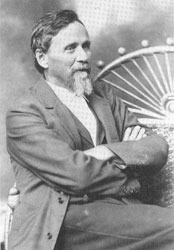 You will find cause for a man to reason that when they are all in their normal position that every part is in proper condition for health.
You will find cause for a man to reason that when they are all in their normal position that every part is in proper condition for health.
—Autobiography of A. T. Still
When you know the differences between the normal and the abnormal structure you have learned the all-absorbing first question, that you must take your abnormal case back to the normal, lay it down, and be satisfied to leave it. Never leave your case until you have obtained such results. Thus it is far better to familiarize your eye and your hand with the normal before you can approach the abnormal intelligently.
—Autobiography of A. T. Still
The work of the Osteopath is to adjust the body from the abnormal to the normal; then the abnormal condition gives place to the normal and health is the result of the normal condition . . .
—Osteopathy Research and Practice
If health is perfect, it only proves perfect harmony in the physiological action of the body in all its parts and functions. Any variation from perfect health marks a degree of functional derangement in the physiological department of man. Efforts at restoration from the diseased to the healthy condition should present but one object to the mind, and that is to explore minutely and seek the variation from normal.
—Philosophy and Mechanical Principles of Osteopathy
6. Holism
I feel that twenty-five years of constant study on the parts of man, separated and combined, has prepared me fairly well to enter the higher classes as a beginner to study the active laws of life—to inquire into the hows and whys of the workings and failures of the whole being.
—Autobiography of A. T. Still
We look at the body in health as meaning perfection and harmony, not in one part, but in the whole.
—Philosophy and Mechanical Principles of Osteopathy
7. Anatomy: The Architecture of the God of Nature
The more we know of the architecture of the God of Nature, and the closer we follow it, the better we will be pleased with the results of our work.
—Osteopathy Research and Practice
You begin with anatomy, and you end with anatomy, a knowledge of anatomy is all you want or need . . .
—Philosophy of Osteopathy
Oh Lord! Give me more anatomy each day I live, because experience has taught me the unavoidable demands when in the “sick room.”
—Philosophy of Osteopathy
8. Mechanical Principles = Biomechanics
The mechanical principles on which Osteopathy is based are as old as the universe.
—Philosophy of Osteopathy
Before you can go out in the world and fight the fight, you must master human anatomy and physical laws.
—Autobiography of A. T. Still
All patterns for the mechanic to imitate in all his inventions are found in man.
—Autobiography of A. T. Still
The mechanical osteopath who is well versed in the anatomy of this region, its blood supply, its drainage and the functioning processes of the nervous system sees nothing whatever in this definition that is satisfactory or beneficial regarding the cause which has produced this condition.
—Osteopathy Research and Practice
9. Equilibrium of Form and Function
. . . [T]he body itself . . . may recover from displacements, disorganizations, derangements, and consequent disease, and regain its normal equilibrium of form and function in health and strength.
—Autobiography of A. T. Still
Let us reason that blood has a great and universal duty to perform, if it constructs, nourishes, and keeps the whole nerve system normal in form and function.
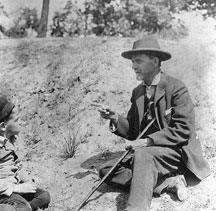 —Philosophy of Osteopathy
—Philosophy of Osteopathy
When you have adjusted the physical to its normal demands, Nature universally supplies the remainder. I think I have said enough of the importance of the truly normal in form and functions of the organs of the body to take up and make special application of this philosophical guide to a careful search for the true cause of any variation from the healthy condition.
—Philosophy and Mechanical Principles of Osteopathy
10. Cause and Effect
I have but one object in writing on this subject, which is to present the truth as nearly as possible and assist and aid the Osteopath to reason from the effect he sees to the cause which, in many cases, is unseen. He should never dally with the effects but ever go back to the cause which when corrected results in a disappearance of the effect.
—Osteopathy Research and Practice
I want it understood that I look upon the treating of effects as being as unwarranted as it would be for the fireman of a city to fight the smoke and pay no attention to the cause that produces it.
—Osteopathy Research and Practice
Does not Nature, with a knowledge of the machinery, offer a more reliable system of locating cause by adjusting that machinery so that it can remove the cause and change effect?
—Philosophy and Mechanical Principles of Osteopathy
11. Disease: From an Osteopathic Perspective
We say disease when we should say effect; for disease is the effect of a change in the parts of the physical body. Disease in an abnormal body is just as natural as is health when all the parts are in place.
—Osteopathy Research and Practice
When we use the word “disease,” we mean anything that makes an unnatural showing in the body.
—Philosophy and Mechanical Principles of Osteopathy
I want to say that when an Osteopath explores the human body for the cause of disease he knows he is dealing with complicated perfection.
—Osteopathy Research and Practice
Sickness is an effect caused by the stoppage of some supply of fluid or quality of life.
—Autobiography of A. T. Still
To cure disease the abnormal parts must be admitted to the normal.
—Osteopathy Research and Practice
The fundamental principles of osteopathy are different from those of any other system and the cause of disease is considered from one standpoint, viz.: disease is the result of anatomical abnormalities followed by physiological discord. To cure disease the abnormal parts must be adjusted to the normal; therefore other methods that are entirely different in principle have no place in the osteopathic system.
—Osteopathy Research and Practice
Osteopathy is based on the perfection of Nature’s work. When all parts of the human body are in line we have health. When they are not the effect is disease.
—Osteopathy Research and Practice
12. Fascia
I write at length of the universality of the fascia to impress the reader with the idea that this connecting substance must be free at all parts to receive and discharge all fluids, and to appropriate and use them in sustaining animal life, and eject all impurities, that health may not be impaired by dead and poisonous fluids. A knowledge of the universal extent of the fascia is imperative, and is one of the greatest aids to the person who seeks the cause of disease.
—Philosophy and Mechanical Principles of Osteopathy
I know of no part of the body that equals the fascia as a hunting-ground. I believe that more rich golden thoughts will appear to the mind’s eye as the study of the fascia is pursued than of any other division of the body.
—Philosophy and Mechanical Principles of Osteopathy
13. Fluids
If a thousand kinds of fluids exist in our bodies, a thousand uses require them, or they would not appear. To know how and why they exist is the economy of life is the study of the man who acts only when he knows at what places each must appear and fill the part and use for which it is designed. If the demand for a substance is absolute, its chance to act and answer that call and obey the command must not be hindered while in preparation, nor on its journey to its destination, for upon its power all action may depend.
—Philosophy and Mechanical Principles of Osteopathy
When matter ceases to be divisible, it then becomes a fluid of life . . .
—Philosophy and Mechanical Principles of Osteopathy
14. Lymphatics
We strike at the source of life and death when we go to the lymphatics.
—Philosophy and Mechanical Principles of Osteopathy
No space is so small that it is out of connection with the lymphatics, with their nerves, secretory and excretory ducts. The system of lymphatics is complete and universal in the whole body.
—Philosophy and Mechanical Principles of Osteopathy
15. Vascular System
The rule of the artery is absolute, universal, and must be unobstructed or disease will result.
—Autobiography of A. T. Still
16. Cerebrospinal Fluid: The Great River of Life
Another period of observation appears to the philosopher. We find partial or universal discord from the lowest to the highest in action and death . . . We continue our investigation, but the results obtained are not satisfactory, and another leaf is opened and the question appears, why and where is the mystery, what quality and element of force and vitality has been withheld? A thought strikes him that the cerebro-spinal fluid is one of the highest known elements that are contained in the body, and unless the brain furnishes this fluid in abundance, a disabled condition of the body will remain. He who is able to reason will see that this great river of life must be tapped and the withering field irrigated at once, or the harvest of health be forever lost.
—Philosophy and Mechanical Principles of Osteopathy
The fluids of the brain are of a finer order than any fluids supplying the whole viscera.
—Philosophy and Mechanical Principles of Osteopathy
17. Motion
Life and matter can be united, and that union cannot continue with any hindrance to the free and absolute motion.
—Philosophy of Osteopathy
[The unerring Architect] has placed all the principles of motion, life, and all its remedies to be used in sickness inside of the human body. He has placed them somewhere in the structure . . .
—Autobiography of A. T. Still
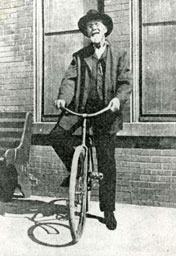 First the material body, second the spiritual being, third a being of mind which is far superior to all vital motions and material forms, whose duty is to wisely manage this great engine of life.
First the material body, second the spiritual being, third a being of mind which is far superior to all vital motions and material forms, whose duty is to wisely manage this great engine of life.
—Philosophy of Osteopathy
[The] processes of Life must be kept in motion.
—Philosophy of Osteopathy
We speak of life, but know of it only as we see bodies move by life back of the visible matter. Does Nature have a finer matter that is invisible and that moves all that is visible to us? Life surely is a very finely prepared substance, which is the all-moving force of Nature, or that force that moves all nature from worlds to atoms. It seems to be a substance that contains all the principles of construction and motion, with the power to endow that which it constructs with the attributes necessary to the object it has formulated from matter and sent forth as a the incomprehensible, appears with man as the crowning effort of the wisdom of an all-wise chemist, be he known as God, Nature, the Unknowable, or the ever-living Genius of the universe.
—Philosophy and Mechanical Principles of Osteopathy
18. Stagnation
Local shocks affect the whole system, the nerve and blood supply to every part of the body.
—Osteopathy Research and Practice
If the arterial gates are open and the venous are closed, a variation from normal venous drainage results, and the detained venous blood becomes stagnant
—Osteopathy Research and Practice
Venous blood, as the student well knows, should not be tolerated to remain long enough for stagnation, fermentation and inflammation, because when it is detained by any sort of ligation, pressure or constriction, it loses its vitality and is in a condition that allows it to set tip the process of decomposition. Thus we have the irritation caused by a venous congestion in the parts, which soon passes on to inflammation . . .
—Osteopathy Research and Practice
We conclude that when the fluids of the body are stopped in the fascia, organs and other parts of the system, stagnation, fermentation, heat and general confusion will follow . . .
—Osteopathy Research and Practice
19. Remedies: God’s Drugstore
Has not nature’s God been thoughtful enough to place in man all the elements and principles that the word “remedy” means?
—Autobiography of A. T. Still
The body of man [is] God’s drug-store and [has] in it all liquids, drugs, lubricating oils, opiates, acids, and anti-acids, and every sort of drug that the wisdom of God thought necessary for human happiness and health.
—Autobiography of A. T. Still
20. Solvents
The doctor of osteopathy has much to think about when he consults natural remedies, and how they are supplied and administered, and as disease is the effect of tardy deposits in some or all parts of the body, reason would bring us to a search for a solvent of such deposits, which hinder the natural motion of blood and other fluids in functional works, and with that solvent we are to keep the body pure from any substance that would check vital action.
—Philosophy and Mechanical Principles of Osteopathy
Nature, at will, can and does produce solvents, necessary to melt down deposits of fiber, bone, or any fluid or solid found in the human body.
—Autobiography of A. T. Still
The solvent powers of life dissolve all fluids and solids from blood to bone.
—Autobiography of A. T. Still
21. Truth: The Complete Work of Nature
We often speak of truth. We say “great truths,” and use many other qualifying expressions. But no one truth is greater than any other truth. Each has a sphere of usefulness peculiar to itself. Thus we should treat with respect and reverence all truths, great and small. A truth is the complete work of Nature, which can only be demonstrated by the vital principle belonging to that class of truths. Each truth or division, as we see it, can only be made known to us by the self-evident fact which this truth is able to demonstrate by its action.
—Philosophy and Mechanical Principles of Osteopathy
Truth has no cause to fear opinions. It wants no flattery. It neither loves nor hates. It is food and comfort.
—Osteopathy Research and Practice
22. Transformation
By reason we arrive at the conclusion that the duties of nature are perpetual labor, through the vast cycles of eternity, conducted by the skillful plan of God, with the power to transpose and transform all substances, uniting them in such proportions and endowing them with such qualities and conditions as will make perfect work.
—Autobiography of A. T. Still
23. Tempo: Traveling in Harmony with Nature’s Truths
To obtain good results, we must blend ourselves with and travel in harmony with Nature’s truths.
—Philosophy and Mechanical Principles of Osteopathy
Blood, albumin, gall, acids, alkalies, oils, brain-fluid, and other substances, formed by associations while in physiological processes of formation, must be on time, in place, and measured abundantly, that the biogneic laws of Nature can have full power and time to act.
—Philosophy and Mechanical Principles of Osteopathy
24. Expanding the Reach of Osteopathic
Principles and Practice
DO means Dig On.
—Andrew Taylor Still, personal papers

REFERENCE LEGEND:
Still, A. T. Autobiography of A. T. Still, (1908; reprint, American Academy of Osteopathy, 1981)
Still, A. T. Osteopathy Research and Practice, Eastland Press, 1992
Still, A. T. Philosophy of Osteopathy (1899, reprint, American Academy of Osteopathy, 1977)
Still, A. T. Philosophy and Mechanical Principles of Osteopathy, (1902, reprint, Osteopathic Enterprises, 1986)
top